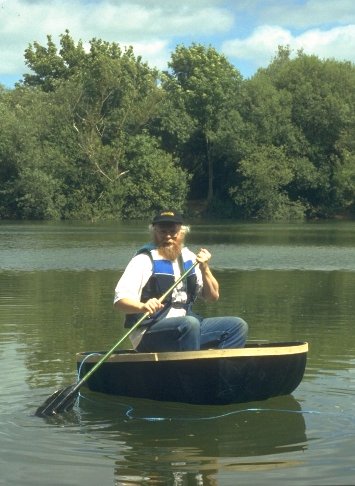
While I was waiting for the next stage, I thought it
might be a good idea to talk to my sawmill man again .....
I'm not very good at complaining about things, but I thought that
I'd had a poor deal with my ash laths. I'd explained clearly what
I wanted to do with the laths, so I was quite disappointed when
I found that the majority of what I had wasn't at all suitable
for bending into the tightish curves needed in a coracle.
I psyched myself up to my most assertive mental state and
phoned 'the man'. He was very reasonable and listened to
my complaint without arguing. He said that he'd look at
what other stocks of ash he had and phone me back.
After a few days he did indeed call back and said that he
couldn't give any guarantees that the other ash plank he
had would be knot free, but he thought that it was much
better than the original lot he'd sold me.
He was prepared to either give me this new plank, sawn up
into laths for no extra cost, or refund about two thirds
of my money. Both offers seemed very fair, and as I hadn't
found anywhere else that would cut ash laths at a sensible
price, I opted for more laths so that our friend could
build her coracle, and with luck, I might be able to build
a second one - better hopefully, with experience.
While that was going on, the coracle was slowly drying in
the garage. After a week, I lifted the damp blanket off it
that was supposed to keep it damp but allow it dry slowly.
Because the chipboard underneath was still very wet, the
blanket had retained much of the wetness so it hadn't
really dried out. I removed the blanket and chipboard
and left it to dry for another week.
 |
It seemed very dry by the end of the next week, so I tried out the calico sheet covering for size, expecting that I'd need to sew two bits together. The one sheet fitted perfectly so I set about stretching it around the frame and stapling it to the inside of the gunwale. |
| The covered frame |
| The next stage was to paint the cloth with the bituminous
paint. This is obviously a bit critical to the success
or otherwise of the coracle.
I'd selected the paint mostly on the basis of price: £8·99 rather than £19·99, because there was little else to choose between the paints judging by the description on the can. One thing that did appeal about the can I bought though, was that it said that it was water soluble - seriously. |
 |
| Now painted, awaiting the outer gunwale |
 |
I wasn't too surprised that it floated when gently placed on the
water, but was pleasantly surprised that it continued floating
when I put all my weight into it.
Both balancing in it, and propelling it in the required direction are definitely an art that needs to be learned! In the ten minutes or so that I was afloat, I sort of got the hang of it, but I certainly wouldn't call myself proficient yet. I obviously didn't look as nervous as I felt because Barbara then agreed to have a go too, and succeeded equally well in staying dry. It did seem to allow a little water in, so I have subsequently put a second layer of calico over the vulnerable bottom area for added strength as well as waterproofing. And that's it. We now have a coracle which we hope will provide some fun while we're out on Saros, and has been educational to build. |
| A nervous coracler! |